Photopolymerised Coatings with Nanopigments Based on Dye Mixtures
Abstract
1. Introduction
2. Experimental
2.1. Materials
2.2. Methods
3. Results and Discussion
3.1. NP Synthesis Based on Dye Mixtures
- -
- The structure, ratio, and total concentration of the applied dyes in the solution;
- -
- The structure of the surfactants used for MMCS production and their contents of montmorillonite;
- -
- The ratio of the quantity of MMCS to the volume of the dye solution.
3.2. Some Features and Advantages of NPs
3.3. UV Inks Based on NPs with Dye Mixtures
3.4. Nano-Sized Structure of Printing Composition with NPs Based on Dye Mixtures
4. Conclusions
Author Contributions
Funding
Institutional Review Board Statement
Informed Consent Statement
Data Availability Statement
Conflicts of Interest
References
- Lebedevaite, M.; Talacka, V.; Ostrauskaite, J. High biorenewable content acrylate photocurable resins for DLP 3D printing. J. Appl. Polym. Sci. 2021, 138, 50233. [Google Scholar] [CrossRef]
- Mihaylova, E.M. Water-Soluble Holographic Photopolymers for a Sustainable Future—A Review. Coatings 2022, 12, 1765. [Google Scholar] [CrossRef]
- Irfan, M.; Martin, S.; Obeidi, M.A.; Miller, S.; Kuster, F.; Brabazon, D.; Naydenova, I. A Magnetic Nanoparticle-Doped Photopolymer for Holographic Recording. Polymers 2022, 14, 1858. [Google Scholar] [CrossRef]
- Tomašegović, T.; Poljaček, S.M.; Jakovljević, M.S.; Urbas, R. Effect of the Common Solvents on UV-Modified Photopolymer and EPDM Flexographic Printing Plates and Printed Ink Films. Coatings 2020, 10, 136. [Google Scholar] [CrossRef]
- Shaikh, S.F. Nanomaterials Applied in Coatings: Synthesis, Structures, Properties, and Applications. Coatings 2022, 12, 1773. [Google Scholar] [CrossRef]
- Mathiazhang, A.; Joseph, R. Nanotechnology-a new prospective in organic coating—Review. Int. J. Chem. Eng. Appl. 2011, 2, 225–237. [Google Scholar]
- Selvam, S.; Rizwan, B.; Kalarical, J.S.; Sriman, N.S.; Balachandran, U.N. Functional pigments from chromium (III) oxide nanoparticles. Dyes Pigments 2012, 94, 548–552. [Google Scholar]
- Dayakar, T.; Rao, K.V.; Chakra, C.S. Synthesis and characterization of MgFe2O4(0.5)/TiO2(0.5) nano ceramic pigment by mechano-chemical synthesis. Int. J. Nano Sci. Technol. 2013, 1, 01–08. [Google Scholar]
- Patel, M.A.; Bhanvase, B.A.; Sonawane, S.H. Production of cerium znc molybdate nano pigment by innovative ultrasound assisted approach. Ultrason. Sonochemistry 2013, 20, 906–913. [Google Scholar] [CrossRef] [PubMed]
- Blosi, M.; Albonetti, S.; Gatti, F.; Baldi, G.; Dondi, M. Au-Ag nanoparticles as for digital decoration. Dyes Pigments 2012, 94, 355–362. [Google Scholar] [CrossRef]
- Cavalcante, P.M.T.; Dondi, M.; Guarini, G.; Raimondo, M.; Baldi, G. Color performance of ceramic nano-pigments. Dyes Pigments 2009, 80, 226–232. [Google Scholar] [CrossRef]
- Mara, M.; Csanády, A.; Tolnaj, G.; Németh, P.; Bertóti, I.; Sajo, I.; Papp, K.; Hargitai, H. Nano-micro pigment composites for high performance paints. Mater. Sci. Forum 2010, 659, 203–208. [Google Scholar]
- Wilson, J.H.; Bradbury, R.; Annable, T.; Yeates, S.G. Inkjet printable aqueous dye-polymer nanoparticles. Dyes Pigments 2012, 95, 201–205. [Google Scholar] [CrossRef]
- Zhao, X.; Meng, Q.; Li, Q. Hydrophobic dye/polymer colorants synthesized by miniemulsion solvent evaporation technique. Dyes Pigments 2014, 100, 41–49. [Google Scholar] [CrossRef]
- Jiang, B.; Tao, P.H.; Huang, Y.D. Study of the adsorption performance and preparation of functional nano-silica pigment particles. Dyes Pigments 2014, 104, 169–174. [Google Scholar] [CrossRef]
- Raha, S.; Ivanov, I.; Quazi, N.H.; Bhattacharya, S.N. Photo-stability of rhodamine-B/montmorillonite nanopigments in polypropylene matrix. Appl. Clay Sci. 2009, 42, 661–666. [Google Scholar] [CrossRef]
- Raha, S.; Quazi, N.; Ivanov, I.; Bhattacharya, S. Dye/clay intercalated nanopigments using commercially available non-ionic dye. Dyes Pigments 2012, 93, 1512–1518. [Google Scholar] [CrossRef]
- Tang, P.; Feng, Y.; Li, D. Facile synthesis of multicolor organic-inorganic hybrid pigments based on layered double hydroxides. Dyes Pigments 2014, 104, 131–136. [Google Scholar] [CrossRef]
- Zavodchikova, A.A.; Safonov, V.V.; Ivanov, V.B. Nanopigments on the basis of dyes mixtures. Izvestiya Vysshikh Uchebnykh Zavedenii. Seriya Teknol. Tekst. Promyshlennosti 2011, 4, 82–85. [Google Scholar]
- Zavodchikova, A.A.; Ivanov, V.B.; Safonov, V.V.; Solina, E.V. Photopolymerizable Composition for Printing on Textile. Materials. Patent 2472197, 13 March 2013. [Google Scholar]
- Zavodchikova, A.A.; Safonov, V.V.; Solina, E.V.; Ivanov, V.B. Ultraviolet paints based on nanopigments for printing on textile materials. Text. Res. J. 2014, 84, 50–60. [Google Scholar] [CrossRef]
- Ivanov, V.B.; Shlyapintokh, V.Y. Synergism in photostabilization of polymers. In Developments in Polymer Stabilisation—8; Scott, G., Ed.; Elsevier Applied Science Publisher: London, UK, 1987; pp. 20–43. [Google Scholar]
- Venu, S.S.; Kochupurayil, A.M.; Swapankumar, G. Rhodamine 6G intercalated montmorillonite nanopigments—Polyethelene composites: Facile synthesis and ultraviolet stability study. Am. Ceram. Soc. 2011, 94, 1731–1736. [Google Scholar]
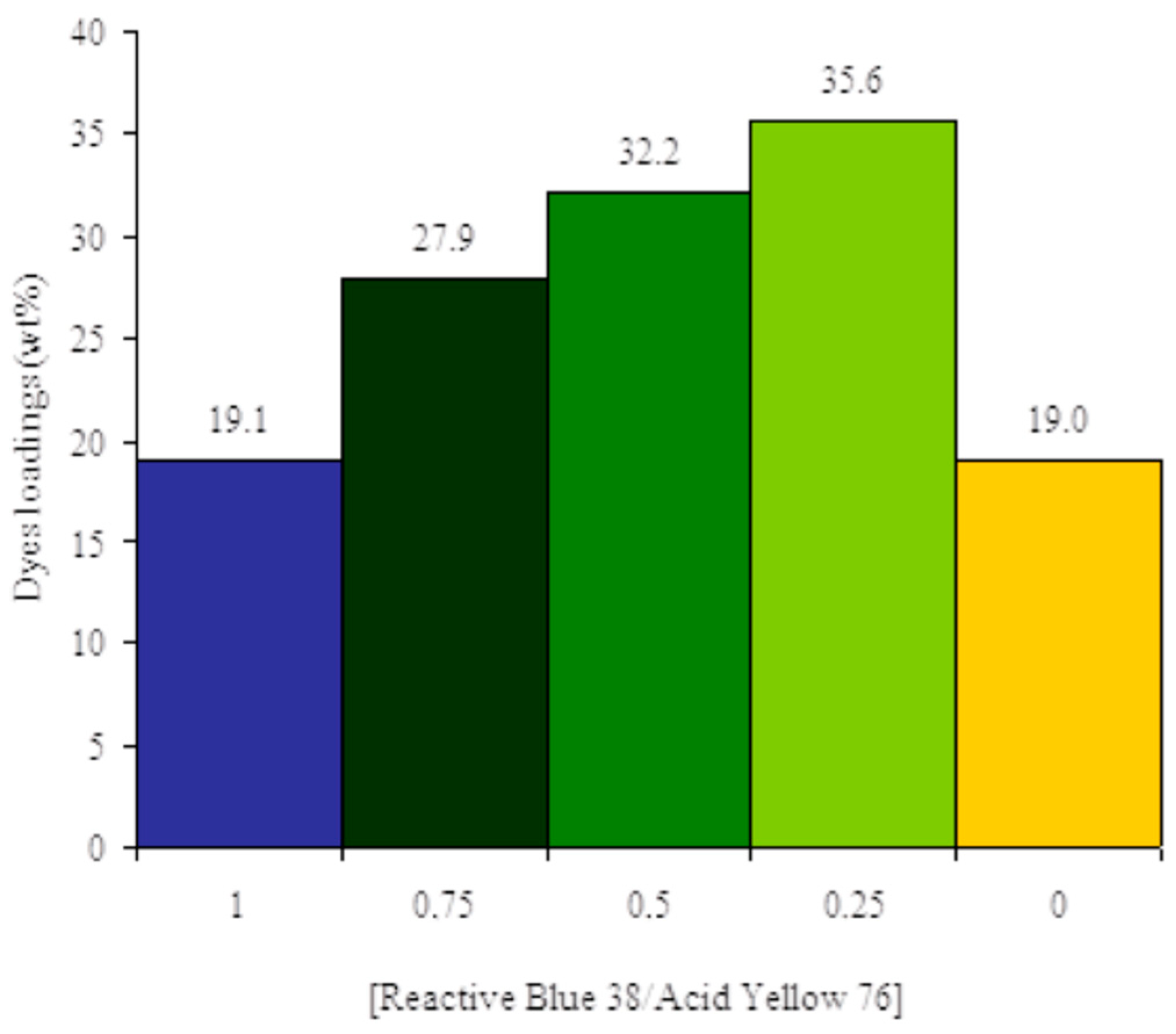
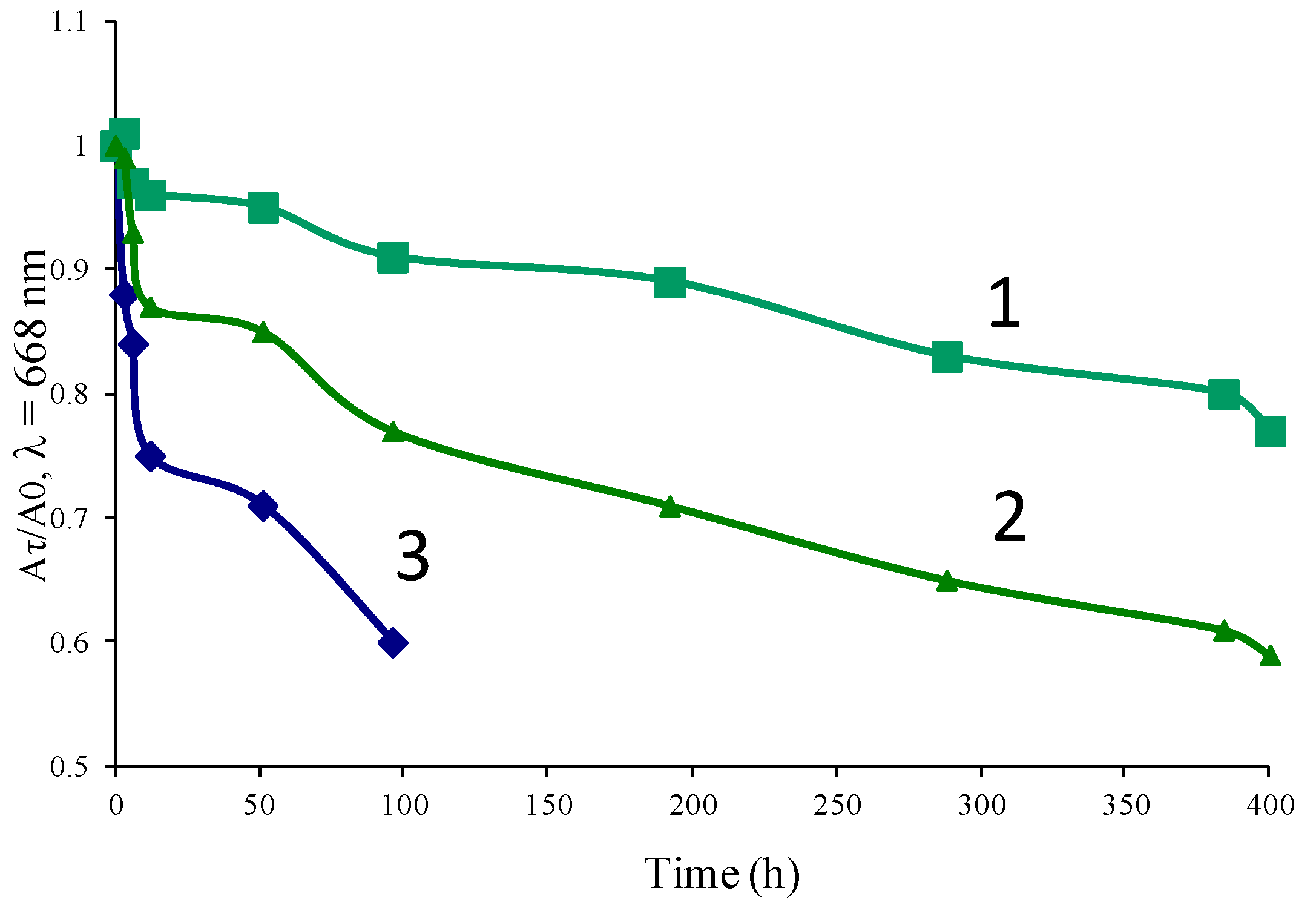
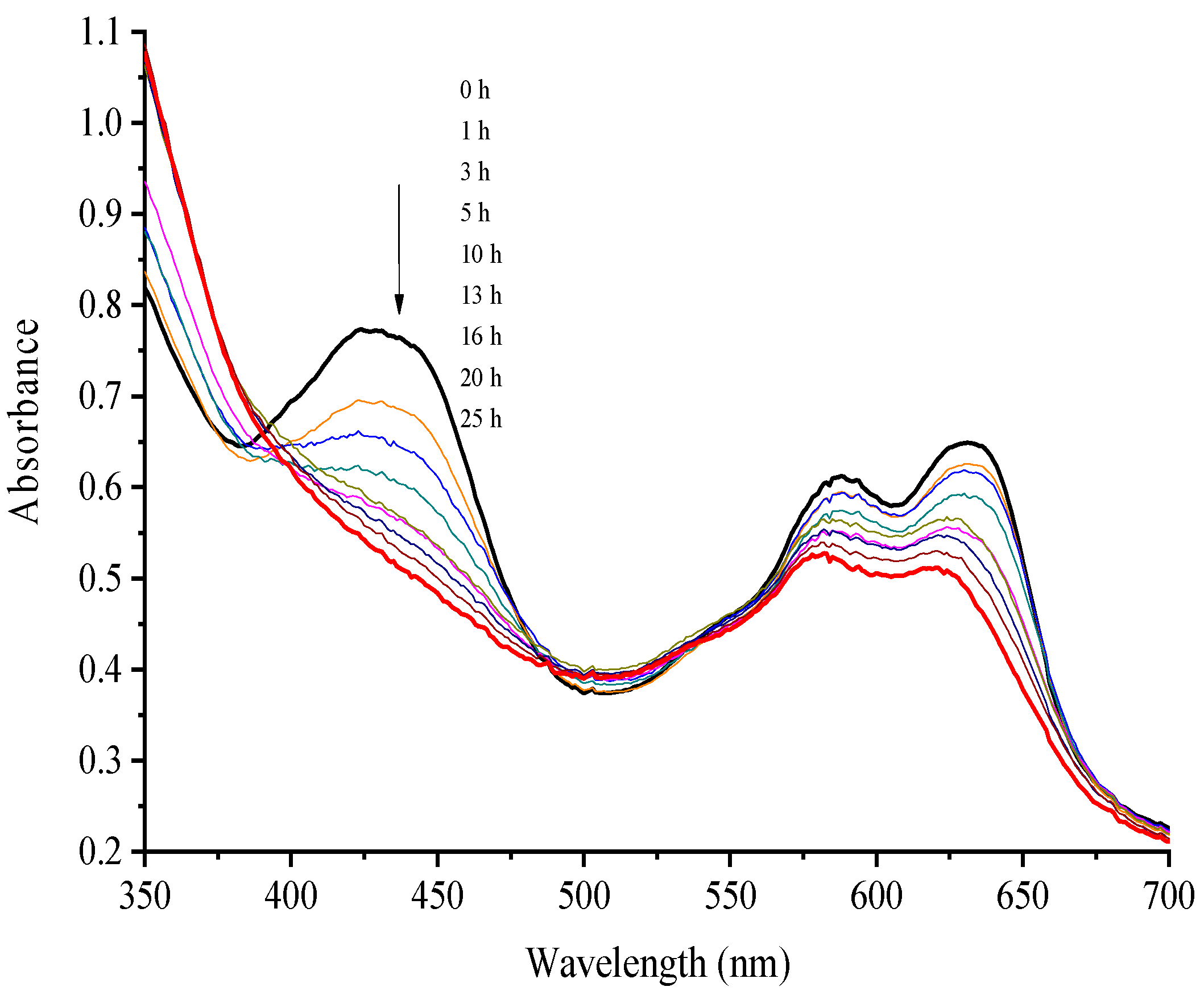
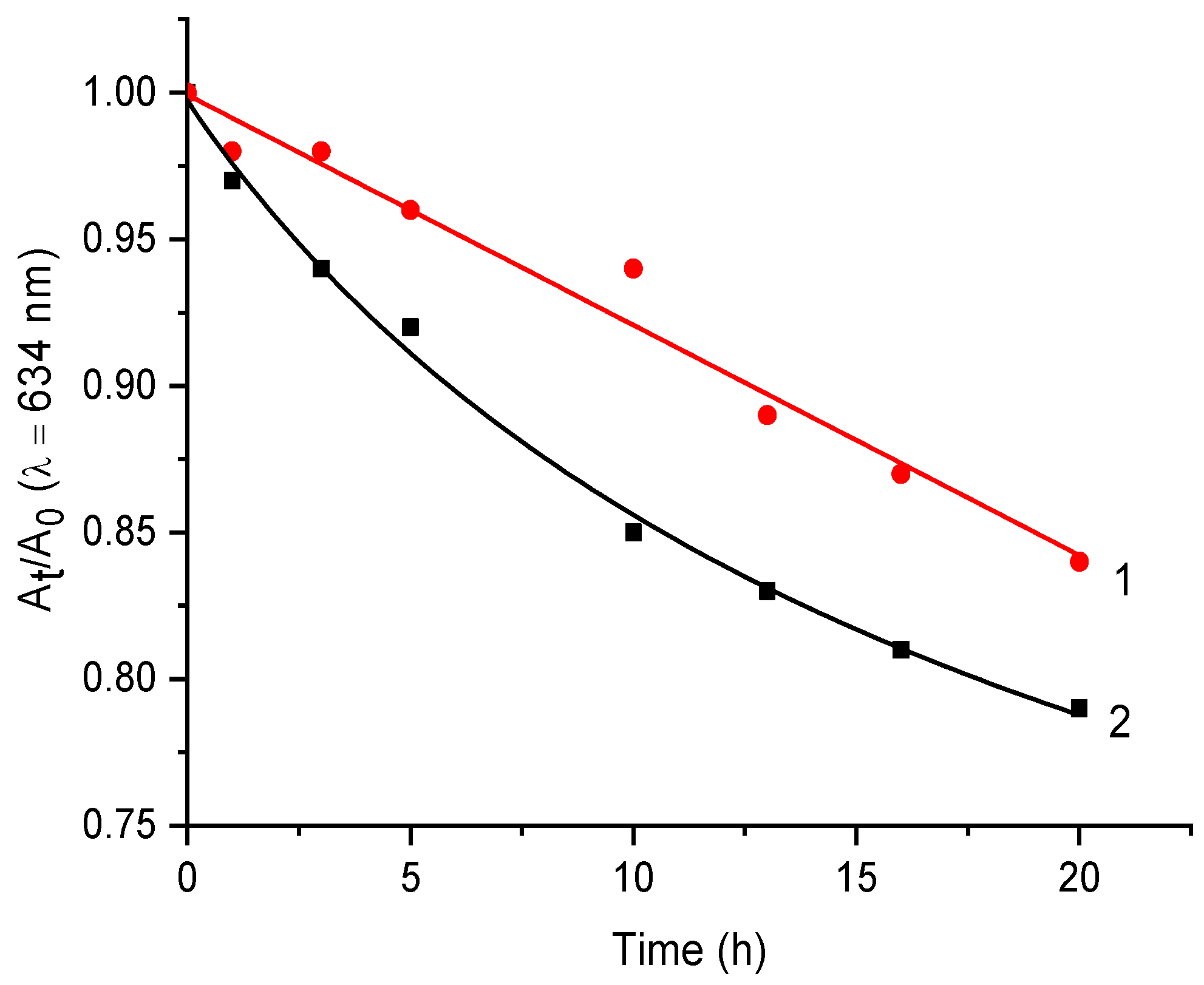

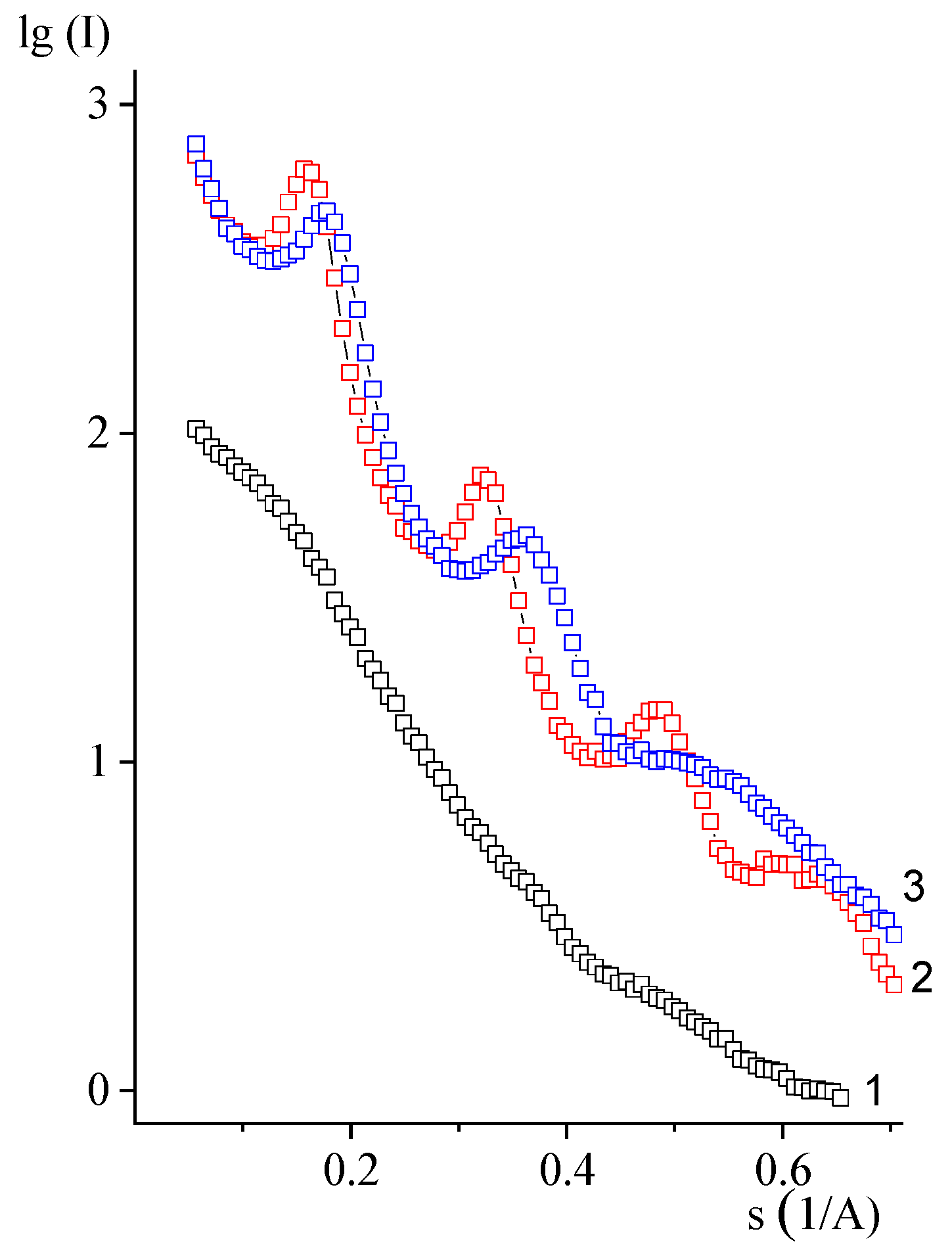
| MMCS | Dyes (wt%) | Solvent | Dye Loading in NP a (wt%) | NP Content in PMMA (wt%) | Colour Coordinates | ||
|---|---|---|---|---|---|---|---|
| L* | a* | b* | |||||
| MMCS-2 | Disperse Blue 56 (10)/Disperse Yellow 13 (10) | EtOH | 17.0 | 8 | 18.50 | −41.11 | 0.10 |
| MMCS-2 | Disperse Blue 56 (5)/Disperse Yellow 13 (15) | EtOH | 16.1 | 10 | 23.28 | −46.16 | 19.57 |
| MMCS-1 | Direct Blue 199 (5)/Direct Yellow 1(15) | EtOH/H2O | 13.4 | 10 | 27.97 | −52.43 | 36.56 |
| MMCS-1 | Direct Blue 199 (10)/Direct Yellow 1 (10) | EtOH/H2O | 13.3 | 10 | 17.52 | −43.47 | 18.55 |
| MMCS-2 | Disperse Orange 30 (15)/Disperse Blue 7 (15) | Me2CO/H2O | 15.0/15.0 | 30 | 31.87 | −32.91 | 25.44 |
| MMCS-2 | Direct Red 239 (30)/Direct Violet 9 (10) | EtOH/H2O | 16.9/7.8 | 4 | 8.50 | 34.55 | 11.92 |
| MMCS-2 | Direct Red 239 (20)/Direct Violet 9 (20) | EtOH/H2O | 10.5/16.4 | 4 | 4.97 | 23.32 | 4.56 |
| MMCS-1 | Basic Yellow 24 (20.4)/Direct Yellow 1 (10) | EtOH/H2O | 20.3/9.8 | 8 | 58.67 | 32.10 | 93.80 |
| MMCS-2 | Acid Violet 49 (18)/Disperse Blue 56 (18) | Me2CO/H2O | 2.4/18.0 | 8 | 1.96 | 3.63 | −6.62 |
| MMCS-2 | Basic Red 18 (30)/Acid Violet 49 (3.3) | EtOH/H2O | 19.6/3.3 | 8 | 4.71 | 15.78 | 4.70 |
| MMCS-2 | Acid Violet 49 (20)/Acid Yellow 76 (30) | EtOH/H2O | 6.7/28.8 | 4 | 0.73 | 0.38 | 0.13 |
| MMCS-2 | Direct Yellow 1 (20)/Direct Red 239 (20) | EtOH/H2O | 16.0/8.2 | 4 | 35.24 | 60.67 | 56.96 |
| MMCS-2 | Acid Yellow 76 (20)/Reactive Blue 38 (20) | EtOH/H2O | 16.9/15.3 | 4 | 10.86 | −24.02 | 14.92 |
| Nanopigment | MMCS | Dye Loading in NP (wt%) | NP Content in PMMA (wt%) | Colourfastness |
|---|---|---|---|---|
| Direct Violet 9 | MMCS-2 | 19.8 | 4 | 4–5 |
| Direct Red 239/Direct Violet 9 | MMCS-2 | 10.5/16.4 | 4 | 5–6 |
| Direct Red 239/Direct Violet 9 | MMCS-2 | 16.9/7.8 | 4 | 3–4 |
| Direct Red 239 | MMCS-2 | 18 | 4 | 2–3 |
| Direct Blue 199 | MMCS-1 | 10.5 | 4 | 4 |
| Direct Blue 199/Direct Yellow 1 | MMCS-1 | 13.3 | 10 | 7 |
| Direct Blue 199/Direct Yellow 1 | MMCS-1 | 13.4 | 10 | 6–7 |
| Direct Yellow 1 | MMCS-1 | 9.8 | 8 | 6–7 |
| Basic Yellow 24 | MMCS-1 | 20.4 | 4 | 5 |
| Basic Yellow 24/Direct Yellow 1 | MMCS-1 | 20.3/9.8 | 8 | 5 |
| Nanopigment (wt%) | MMCS | Dye Loading in NP a (wt%) | Content of Colouring Component (wt%) | Physicochemical Impacts | Irradiation Time (min) | |||
|---|---|---|---|---|---|---|---|---|
| Dry Rubbing | Distilled Water | Perspiration | Washing | |||||
| Acid Yellow 76/Reactive Blue 38 | MMCS-2 | 16.9/15.3 | 4 | 5/4 | 5/5/5 | 5/5/5 | 5/5/5 | 2 |
| Acid Yellow 76/Reactive Blue 38 | MMCS-2 | 8.5/19.4 | 4 | 5/4 | 5/5/5 | 5/5/5 | 5/5/5 | 2 |
| Direct Yellow 1/Direct Red 239 | MMCS-2 | 16.0/8.2 | 4 | 5/3 | 5/5/5 | 5/5/5 | 5/5/5 | 2 |
| Disperse Blue 56/Disperse Yellow 13 | MMCS-2 | 17.0 | 7 | 5/5 | 5/5/5 | 5/5/5 | 5/5/5 | 2 |
| Direct Blue 199/Direct Yellow 1 | MMCS-1 | 13.3 | 7 | 5/5 | 5/5/5 | 5/5/5 | 5/5/5 | 2 |
| Direct Blue 199/Direct Yellow 1 | MMCS-1 | 13.4 | 7 | 5/5 | 5/5/5 | 5/5/5 | 5/5/5 | 2 |
| Acid Violet 49/Disperse Blue 56 | MMCS-2 | 2.4/18 | 7 | 5/4–5 | 5/5/5 | 5/5/5 | 5/5/5 | 3 |
| Direct Red 239/Direct Violet 9 | MMCS-2 | 10.5/16.4 | 4 | 5/4 | 5/5/5 | 5/5/5 | 5/5/4 | 2 |
| Direct Red 239/Direct Violet 9 | MMCS-2 | 16.9/7.8 | 4 | 5/4–5 | 5/5/5 | 5/5/5 | 5/5/4 | 2 |
| Pigment Irgalite Blue NGA | - | - | 2 | 4/2–3 | 5/5/5 | 5/5/5 | 5/5/5 | 12 |
Disclaimer/Publisher’s Note: The statements, opinions and data contained in all publications are solely those of the individual author(s) and contributor(s) and not of MDPI and/or the editor(s). MDPI and/or the editor(s) disclaim responsibility for any injury to people or property resulting from any ideas, methods, instructions or products referred to in the content. |
© 2023 by the authors. Licensee MDPI, Basel, Switzerland. This article is an open access article distributed under the terms and conditions of the Creative Commons Attribution (CC BY) license (https://creativecommons.org/licenses/by/4.0/).
Share and Cite
Ivanov, V.B.; Solina, E.V.; Levin, P.P. Photopolymerised Coatings with Nanopigments Based on Dye Mixtures. Coatings 2023, 13, 300. https://doi.org/10.3390/coatings13020300
Ivanov VB, Solina EV, Levin PP. Photopolymerised Coatings with Nanopigments Based on Dye Mixtures. Coatings. 2023; 13(2):300. https://doi.org/10.3390/coatings13020300
Chicago/Turabian StyleIvanov, Viktor B., Elena V. Solina, and Peter P. Levin. 2023. "Photopolymerised Coatings with Nanopigments Based on Dye Mixtures" Coatings 13, no. 2: 300. https://doi.org/10.3390/coatings13020300
APA StyleIvanov, V. B., Solina, E. V., & Levin, P. P. (2023). Photopolymerised Coatings with Nanopigments Based on Dye Mixtures. Coatings, 13(2), 300. https://doi.org/10.3390/coatings13020300








